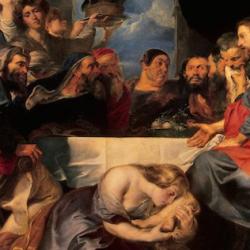Luke’s account of the crucifixion is organized in a neatly chiastic form:
A. Simon of Cyrene carries Jesus’ cross, 23:26
B. Women follow Jesus, beating their breasts, 23:27-31
C. Criminals crucified with Jesus, 23:32-33
D. Jesus forgives mockery and abuse, 23:34-38
C’. One criminal mocks Jesus, the other believes, 23:39-43
B’. Events of Jesus’ death lead crowd to beat their breasts; women stand at a distance, 23:44-49
A’. Joseph of Arimethea puts Jesus in his own tomb, 23:50-56
Several things emerge from the parallels here. First, the whole scene is framed by brief views of two men who do not go along with the people who have agreed to put Jesus to death. Simon and Joseph are both from outside Jerusalem, and both display a remarkable degree of devotion to Jesus. Simon’s devotion is more symbolic than intentional; there is no sign that he’s a real disciple, but he’s the only one in the book of Luke who actually does what Jesus exhorts His disciples to do ?Etaking up the cross. Joseph is a pious Jew, like Elizabeth, Zecharias, Simeon, and Anna in the “infancy narratives,” one who is waiting for the kingdom and apparently associates Jesus with the coming of the kingdom.
Second, the B sections help to frame the account with references to people mourning over what is happening to Jesus. The women’s mourning in vv 27-31 foreshadows the mourning of the people after the death of Jesus, and both together forshadow the great act of repentance at Pentecost in Acts 2. The parallel between Jesus’ warning about the coming destruction of the city (v 29) and the circumstances surrounding the crucifixion (vv 44ff) suggest that the darkness and veil-rending at the time of the crucifixion is a foreshadowing of AD 70, or that the death of Jesus is in fact the destruction of the true temple –
“destroy this temple.”
Finally, the center of the whole passage focuses on Jesus’ forgiveness and the mockery of Jesus by the Jews and Romans. Intriguingly, Jesus extends forgiveness for “what they do” before we KNOW “what they do.” The mockery is recorded after the forgiveness. This sets the mockery in the context of a kind of pre-emptive divine forgiveness. Within the context of the whole passage, the forgiveness points to two things: first, a delay in the final destruction of the city (the B sections) and, second, the reality of a remnant of faithful Jews (the A sections). These are the results of the forgiveness extended by Jesus, results that become more evident in Acts.















